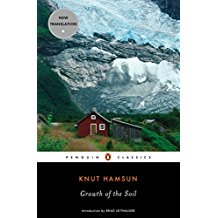The Growth of the Soil, Knut Hamsun, 1917
Hamsun won the Nobel Prize in 1920, largely on the strength of this book. A cross between the Old Testament and Steinbeck’s great family saga novels, the book tells the story of Isak, referred to in the first paragraph as “Man, a human being, the first one who came here. There was no path before him.” Isak walks alone into the wilderness of northern Norway, above the Arctic Circle and carves out of the woods and bogs a large and successful farm, raising a family, buildings, and herds, and becoming a ‘margrave’, a wealthy settler who remains unsophisticated and focused on the work and life on the land. This is a long and challenging book where not much happens but in which characters drawn in deep detail act out life’s course and the value of simple honesty and hard work. Hamsun was a national hero, the Ibsen and Grieg of literature, until after WWII when as a Nazi sympathizer and supporter, he was stripped of his honors and wealth. He died penniless in 1952. Good to have read, but not recommended unless one has a bad case of insomnia.



